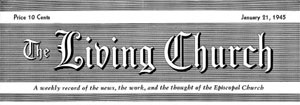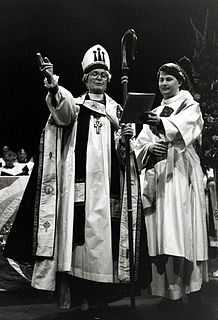
Erman Louie Clay (1936–2019) was an American professor emeritus of English at Rutgers University. He was best known for his long and increasingly successful campaign for the acceptance of gay and lesbian people by Christians in general, and the Episcopal Church in particular.
Gayle Elizabeth Harris was ordained as Bishop Suffragan of the Episcopal Diocese of Massachusetts in 2003, succeeding Barbara Harris. This was the first time in the Episcopal Church in the United States that a woman was succeeded as bishop by another woman.
The September 14-16, 1977 Congress of St. Louis was an international gathering of nearly 2,000 Anglicans in St. Louis, Missouri, united in their rejection of theological changes introduced by the Anglican Church of Canada and by the Episcopal Church in the United States of America in its General Convention of 1976. Anglicans who attended this congress felt that these changes amounted to foundational alterations in the American and Canadian provinces of the Anglican Communion and meant that they had "departed from Christ's One, Holy, Catholic and Apostolic Church." Theological liberalism, revisions to the Book of Common Prayer, and the ordination of women priests were not the only reasons for the split, but they were seen by these churches as evidence of the mainline church's departure from Anglican orthodoxy. This congress was sponsored by the Fellowship of Concerned Churchmen, an organization founded in 1973 as a coordinating agent for laypeople and clergy concerned about the breakdown of faith and order within the Episcopal Church and the Anglican Church of Canada.

The Living Church is a magazine based in Milwaukee, Wisconsin, providing commentary and news on the Episcopal Church and the wider Anglican Communion. In continuous publication since 1878, it has generally been identified with the Anglo-Catholic wing of Anglicanism, and has been cited by national newspapers as a representative of that party. It absorbed a number of earlier Anglo-Catholic publications, including The American Churchman, Catholic Champion (1901), and The Angelus (1904). Theologically and culturally, it tends to have a moderate-to-conservative slant.

The United Episcopal Church of North America (UECNA) is a church in the Anglican tradition and is part of the Continuing Anglican movement. It is not part of the Anglican Communion.
James A. Kowalski was the 9th dean of the Cathedral of Saint John the Divine, New York of the Episcopal Church in New York City, the largest city in the United States. He had been Dean from April 13, 2002, until he stepped down effective June 2017.
Harry Boone Porter Jr. (1923–1999) was an American Episcopal priest, liturgist, and editor of The Living Church magazine.
Albert Arthur Chambers was the seventh bishop of the Episcopal Diocese of Springfield, serving from 1962 to 1972. He then retired in part because he opposed revising the Book of Common Prayer and ordaining women as priests, which would be expressly authorized by the General Convention in 1976.
Arthur Anton Vogel was an American author and prelate who was the fifth bishop of the Episcopal Diocese of West Missouri.

Mary Adelia Rosamond McLeod was the first woman diocesan bishop in the Episcopal Church. She was elected bishop of the Diocese of Vermont on June 5, 1993, at a special convention held at the Cathedral Church of St. Paul in Burlington. Clergy and lay delegates selected her from among five nominees.
Simcox is a surname. Notable people with the surname include:
Hugh Latimer Burleson was bishop of the Diocese of South Dakota in the Episcopal Church in the United States from 1916 to 1931.
Elliott Lorenz Sorge was a bishop in The Episcopal Church, serving in Brazil and the Diocese of Easton.
William Jones Skilton is an American Anglican bishop. He was the first suffragan bishop of the Episcopal Diocese of South Carolina.
Douglass Henry Atwill was bishop of the Episcopal Diocese of North Dakota, serving from 1937 to 1951.
Robert Patrick Varley was a bishop of The Episcopal Church, serving in Nebraska and Minnesota.

Frederick Bethune Bartlett was an American prelate who served as the eighth Bishop of Idaho from 1935 till 1941.
Craig Barry Anderson is a retired American bishop of the Episcopal Church who served as the Bishop of South Dakota from 1984 to 1992.
Eugene Cecil Seaman was an American prelate of the Episcopal Church who was missionary bishop of the Missionary District of Northwest Texas, serving from 1924 to 1945.

Albert Julius duBois was an influential American Anglo-Catholic priest during the 20th century.





